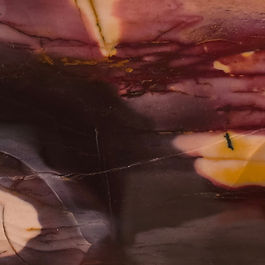
Specimen List
A | B | C | D | E | F | G | H | I | J | K | L | M | N | O | P | Q | R | S | T | U | V | W | X | Y | Z

Lapis Lazuli Slab Afganistan
Afghan Lapis Lazuli is a metamorphic rock dominated by lazurite with calcite and pyrite. It has a deep ultramarine blue, light blue streak, hardness 5–5.5 Mohs, and SG ~2.7–2.9. Found in Sar-e-Sang, Afghanistan, it has been mined for over 6,000 years and historically valued for jewelry and as the source of ultramarine pigment.

Lapis Lazuli Slab Chile
Chilean Lapis Lazuli (Flor de los Andes, Ovalle, Chile) is a lazurite-rich metamorphic rock with more calcite and diopside than Afghan lapis, giving it a lighter, patchier blue with occasional green and minimal pyrite. It has a light blue streak, hardness 5–5.5 Mohs, and SG ~2.7–2.9. Although considered lower grade than Afghan material, it is important as Chile’s national stone and is widely used for carvings, ornaments, and decorative slabs.

Mookaite Slab
Mookaite Jasper is a silicified radiolarian sedimentary rock (chalcedony) from Mooka Creek, Western Australia, composed mainly of SiO₂ with iron oxide colorants. It has a white streak, hardness 6.5–7 Mohs, SG ~2.6, no cleavage, and a conchoidal fracture. Its earthy reds, yellows, creams, and purples make it highly prized in lapidary and decorative uses, and it is unique to Australia.































